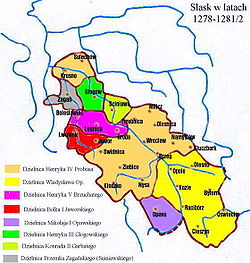Duke of Sagan
| Duchy of Żagań | ||||||||||
|
Księstwo Żagańskie (pl) Zaháňské knížectví (cs) Herzogtum Sagan (de) |
||||||||||
| Silesian duchy | ||||||||||
|
||||||||||
|
Silesia 1278 - 1281: The Duchy of Żagań soon after its creation (gray), west of the Duchy of Głogów (green)
|
||||||||||
| Capital | Żagań | |||||||||
| Political structure | Silesian duchy | |||||||||
| Historical era | Middle Ages Early modern period |
|||||||||
| • | Partitioned from Głogów |
1274 | ||||||||
| • | Vassalized by Bohemia |
1329 | ||||||||
| • | Sold to Saxony | 1472 | ||||||||
| • | Seized by Bohemia | 1549 | ||||||||
|
||||||||||
| Warning: Value not specified for "" | ||||||||||
The Duchy of Żagań (Polish: Księstwo Żagańskie, Czech: Zaháňské knížectví) or Duchy of Sagan (German: Herzogtum Sagan) was one of the duchies of Silesia ruled by the Silesian Piasts. Its capital was Żagań in Lower Silesia, the territory stretched to the town of Nowogród Bobrzański in the north and reached the Lusatian Neisse at Przewóz in the west, including two villages beyond the river (Pechern and Neudorf).
It was formed in 1274 from the western part of the Duchy of Głogów and existed under Piast rule until 1304, then again from 1322 to 1394 and from 1413 to 1472. Since 1329 it was under the suzerainty of Bohemia; it was acquired by the Saxon House of Wettin in 1472, before it was finally seized by the Bohemian king in 1549.
The Żagań ducal title later passed to Bohemian and French nobility, in 1742 it was annexed by Prussia. Re-established as a fief of the Prussian throne in 1844, it formally existed until its official termination in 1935.
After the death of Duke Konrad I of Głogów, his heirs divided his duchy whereby the castle at Żagań became the residence of his youngest son Przemko, the first Duke of Żagań from 1278, who established a monastery of Augustinian Canons here. In 1284 he swapped his estates for the Duchy of Ścinawa and was succeeded by his elder brother Konrad II the Hunchback. When Konrad II died in 1304 all former Głogów estates were re-unified under his surviving brother Henry III.
...
Wikipedia


